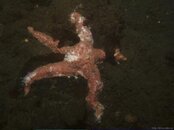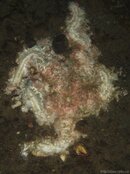Likewise, up in Vancouver BC, my rather non-scientific observation is that it began with Sunflower Starfish and Morning Sun Stars (which had apparently been experiencing a population surge in recent years). After a month or so, when most of those starfish were little more than a "goo" on the bottom, I observed Giant Pink stars beginning to waste away. I've heard mention of it effecting Ochre Starfish, but haven't seen any wasting away myself. (Granted, in late stages, it's impossible to identify what is what). I've still seen Ochres around, but seemingly nowhere near as many as before.. Could be a cognitive bias on that part.
An interesting note is that species that tend to congregate (from what I've observed), such as the Sunflowers and Morning Stars, wasted away first, while other species that don't congregate are either unaffected, or were struck later (such as the Giant Pink star case). Of course, that is only a single data-point, so it would be interesting to hear if others have corroborating or conflicting observations.
Some Giant Pink Stars at Porteau:


I've been blogging some photos/observations of what I've seen up in Vancouver as well: Starfish Die-Off | dive.roko.ca
An interesting note is that species that tend to congregate (from what I've observed), such as the Sunflowers and Morning Stars, wasted away first, while other species that don't congregate are either unaffected, or were struck later (such as the Giant Pink star case). Of course, that is only a single data-point, so it would be interesting to hear if others have corroborating or conflicting observations.
Some Giant Pink Stars at Porteau:


I've been blogging some photos/observations of what I've seen up in Vancouver as well: Starfish Die-Off | dive.roko.ca



